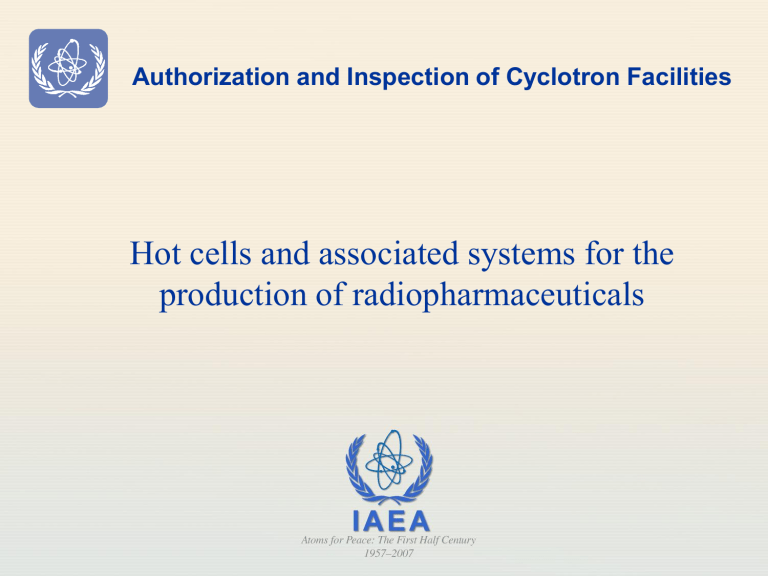Presentation 5

Authorization and Inspection of Cyclotron Facilities
Hot cells and associated systems for the production of radiopharmaceuticals
Authorization and Inspection of Cyclotron Facilities
•
To be familiar with the equipment, facilities and security systems, used in the synthesis of radiopharmaceuticals labeled with positron emitters.
•
Identify the applicable radiation protection requirements.
Authorization and Inspection of Cyclotron Facilities
1.
Transfer from the cyclotron.
2.
What is a hot cell?
3.
Characteristics of hot cells.
4.
Special features of hot minicells.
5.
Synthesis modules.
6.
FDG production.
Authorization and Inspection of Cyclotron Facilities
Transfer
Cyclotron Hot Cells
Radiopharmacy (synthesis)
• After the bombardment in the cyclotron, the radionuclide produced is immediately and automatically transferred to the hot cells located in the radiopharmacy laboratory.
• It is performed through capillary tubes (eg Teflon and
PEEK) through a pneumatic transfer gas push as, for example, He.
Authorization and Inspection of Cyclotron Facilities
:
•
Resistant to ionizing radiation.
•
Excellent strength, rigidity and stability in harsh environments and high temperatures.
•
Low friction coefficient and high wear resistance.
•
Chemically resistant and insoluble by common solvents.
•
Low particle generation and high purity to decrease the risk of contamination.
Authorization and Inspection of Cyclotron Facilities
•
Transfer lines are placed in accessible underground ducts, in a depth between 30 to 40 cm and must be shielded (concrete slabs or several lead plates).
• For small distances, transfer can take less than
2 minutes, including the time required to purge the line.
• Transfer tubes emerge from the shield as close as possible to the destination (hot cell).
Transfer line for liquid target ( 18 F)
Authorization and Inspection of Cyclotron Facilities
Authorization and Inspection of Cyclotron Facilities
Authorization and Inspection of Cyclotron Facilities
Authorization and Inspection of Cyclotron Facilities
Authorization and Inspection of Cyclotron Facilities
Authorization and Inspection of Cyclotron Facilities
•
Transfer lines are inserted, for protection, inside other connection tubes (semirigid) of larger diameter.
• The high activities carried inside the tubes can cause degradation , enhancing activity absorption in its walls, so they have to be replaced periodically (depending on activity produced and the frequency of use).
Authorization and Inspection of Cyclotron Facilities
The length of the transfer line must be as short as possible and in accordance with the regulations, so that:
• It must be ensured a safe and quick transfer (ej: O 15 , T
1/2
2.05 min).
=
• A reduction in the losses of the activity on walls and the probability of damage in line (obstruction or rupture) is guaranteed.
• The lines lenght as short as possible, as well as the associated costs with shielding.
Synthesis labs adjacent to the cyclotron bunker
Authorization and Inspection of Cyclotron Facilities
Authorization and Inspection of Cyclotron Facilities
Authorization and Inspection of Cyclotron Facilities
¿Qué es una celda caliente?
Authorization and Inspection of Cyclotron Facilities
What is a hot cell?
A technological mean of defense, used to manipulate and process radioactive materials. They can be arranged in series, in blocks or individually.
Authorization and Inspection of Cyclotron Facilities
•
Allow the manipulation and process of cyclotron produced radionuclides, using remote means and/or dispensing synthesis and modules (automatic or semiautomatic) that ensure higher safety and accuracy in radiochemical processing and fractionation.
•
Ensure the protection of operators, facilities and environment, to shield the high level of radiation and prevent the uncontrolled spread of radioactive contamination.
• Guarantee, by applying the requirements of
Good Manufacturing Practices (GMP), the synthesis of radiopharmaceuticals in an aseptic environment.
Authorization and Inspection of Cyclotron Facilities
•
Structurally constituted by a steel frame supporting the shield. The cells have in their interior a watertight enclosure, made by stainless steel floor and PVC or acrylic walls.
•
Design based on the principle that the shielding is more economical and more effective if it is as close as possible to the radiation source.
Authorization and Inspection of Cyclotron Facilities
•
To reduce exposure time, the hot cells have some devices for simple maintenance procedures.
•
There are many different cells and remote handling devices, however, the best choice depends on what is expected.
Authorization and Inspection of Cyclotron Facilities
•
The hot cells have different systems and safety devices: ventilation, automatic alarms, compressed air, vacuum, radiation detectors, gauges, etc.
Authorization and Inspection of Cyclotron Facilities
•
Inner surfaces of polished stainless steel of high quality
(grade 316 by its resistance to corrosion) and acrylic or
Lucite (transparent plastic that replaces glass).
•
Automatic, semiautomatic systems or telemanipulators for operations.
Authorization and Inspection of Cyclotron Facilities
• Measurement instruments.
• Installed services.
• Technological equipment.
• Signals and alarms parameters important to safety.
:
Panel command
Authorization and Inspection of Cyclotron Facilities
•
Interior surfaces are smooth, impervious, continuous, without right angles at junctions.
•
Work surfaces with tray structure (with raised edges) to prevent spills.
• Permanent installation of components that can not be cleaned properly, should be avoided.
• Service ducts (electricity, liquids, gases) have seals and penetrate the shielding in a curved form (S-shaped) to prevent radiation streaming.
Authorization and Inspection of Cyclotron Facilities
Scheme of a conventional cell
1. Control panel.
2. Ionization chamber.
3. Leaded glass window.
4. Lighting system.
5. Sealed Enclosure.
6. Lead shielding.
7. Steel cover.
8. Transfer system access.
9. Liquid waste liner vessel.
10. Solid waste liner vessel.
11. Telemanipulator.
12. Radiation Detector.
Authorization and Inspection of Cyclotron Facilities
Accesses
For intervention tasks, maintenance, cleaning or replacement of devices in sealed enclosures, gloves, pneumatically operated guillotine doors or other access are needed.
Sliding doors
The cells will be sealed in accordance with internationally accepted standards.
Authorization and Inspection of Cyclotron Facilities
The introduction of objects and reagents, the extraction of the products and waste disposal systems require sanitary access systems (SAS) maintaining reliable and safe aseptic conditions inside the hot cell.
Authorization and Inspection of Cyclotron Facilities
Different designs of hot cells openings
Vertical front access with telemanipulators.
Minicells with front access.
Central sliding door.
Authorization and Inspection of Cyclotron Facilities
Concrete, lead bricks lead with antimony between 4 -7% to increase its mechanical strength, leaded glass, steel and depleted uranium are used as shielding, supported by rigid steel frames coated with epoxy paint.
The thickness of the shielding must be calculated on the basis of type and energy of radiation and the activity to be manipulated.
During the commissioning of a new hot cell, the integrity of the shielding must be verified!
Authorization and Inspection of Cyclotron Facilities
Transparent leaded glass windows, conveniently placed on the wall, are used to observe the interior of the cells and to make possible visual control of processes and the radiation protection of the operators.
(10 cm lead glass = 5 cm of Pb)
Authorization and Inspection of Cyclotron Facilities
Remote handling
There is commercial availability of two basic designs (by different suppliers) for remote manipulation of materials or equipment within the hot cells:
Manipulators
Must be installed with precision, properly adjusted and tight.
Authorization and Inspection of Cyclotron Facilities
Length of ~ 1 m mounted on shielded ball joints placed on the shielded wall.
Ball joint for the telemanipulator
With interchangeable edge, allows the grip replace without the necessity of removing the enclosure.
Authorization and Inspection of Cyclotron Facilities
Telemanipulators
•
Are used if the wall thickness of the shield is greater than 100 to 150 mm.
•
Recommended if operations are complicated, sensitive or require greater precision .
Authorization and Inspection of Cyclotron Facilities
Ventilation
•
Must comply with the requirements of Good
Manufacturing Practices.
•
To prevent radioactive spreading, the enclosure should be kept in depression.
• To prevent the introduction of powder and the spread of any contaminated particles, HEPA
(High Efficiency Particulate Arresting) filters must be installed (inlet and outlet).
• Activated carbon filters at the exit, for gases.
Authorization and Inspection of Cyclotron Facilities
Minicells
•
Specially designed for PET technology.
•
Used for automated synthesis of PET pharmaceuticals and dispensing into vials and syringes.
•
Completely closed with controlled airflow, double door (exterior is shielding, insulation inside).
Authorization and Inspection of Cyclotron Facilities
• Shielding of lead - 75 mm and more.
• Filtration: HEPA and activated carbon.
• Interlocks: opening and transfer.
• Aseptic conditions (GMP).
• Simple or double cells, with independent operation.
Authorization and Inspection of Cyclotron Facilities
•
Autoclave with capacity for dozens of vials.
•
Radiation detectors inside and outside.
•
Manometer to measure filter clogging.
•
Pressure gauge for measuring the pressure difference between the interior of the cell and the laboratory.
Authorization and Inspection of Cyclotron Facilities
The small half-life of the produced radionuclides and the energy of the annihilation photons lead to the need of attention directed to both the processing and handling, according to regulations.
The chemical synthesis shall be fast, reliable, reproducible, GMP compliant, radiologically safe, automatic and remote.
Synthesis modules
Authorization and Inspection of Cyclotron Facilities
Equipment where all processes (chemical in nature) necessary for the production of PET radiopharmaceuticals are performed.
They operate automatically and through a software control, which monitors the entire process through a computer.
Authorization and Inspection of Cyclotron Facilities
Use of disposable sets of reagents.
Since the final product is injectable, it must be sterile and pyrogen free.
The synthesis module has high technological complexity.
Authorization and Inspection of Cyclotron Facilities
•
Before each synthesis the cell has to be cleaned and the synthesis module reloaded with the reagents necessary for the process.
•
Use of disposable kits or integrated cassettes (preloaded with pharmaceutical reagents) which are positioned or adjusted in a straightforward way, avoids the use of manual measurements of reagents, which suppresses the risk of human error.
Authorization and Inspection of Cyclotron Facilities
• The F18 in the synthesis module reacts in a series of steps with other chemical reagents, and fluorodeoxyglucose (FDG) is produced (typically in 1 hour).
• Subsequently the material is transferred to a dispensing hot cell where, with the help of an automatic dispenser, it proceeds to fill the vials to provide, under aseptic conditions, the final sterilization by autoclaving.
Authorization and Inspection of Cyclotron Facilities
•
The activity is verified with the activimeter.
•
The vials are placed in appropriated containers.
•
Later they are packaged for distribution.
Authorization and Inspection of Cyclotron Facilities
Quality control
Sampling and strict quality controls to ensure the quality of the product to be administered to patients.
Laminar flow


